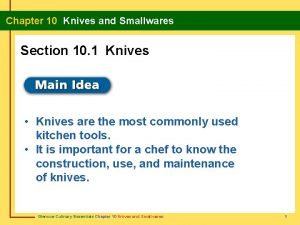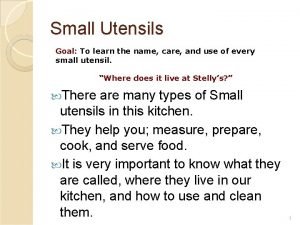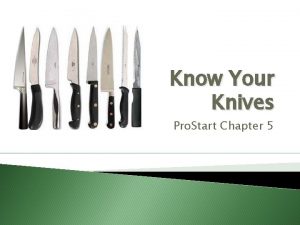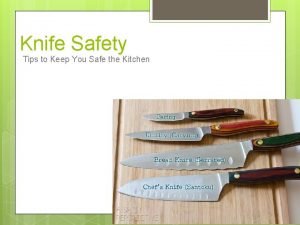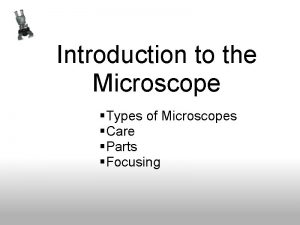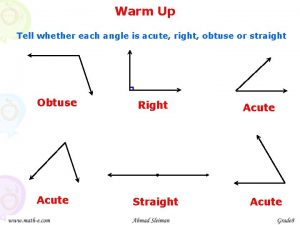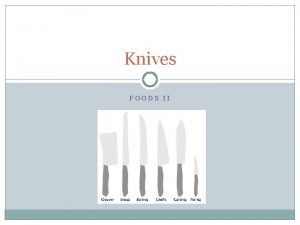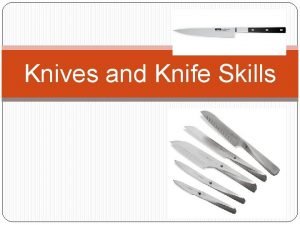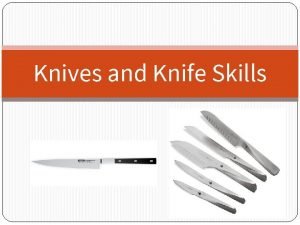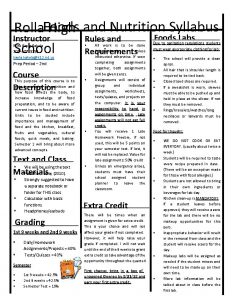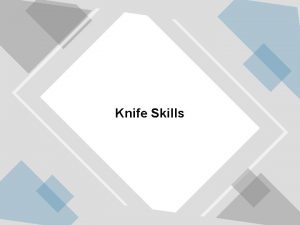Knives FOODS II Types of Knives and Their




























- Slides: 28

Knives FOODS II

Types of Knives and Their Uses �Chef’s knives: A chef’s knife has a strong rigid blade which makes it suitable for a wide range of jobs. Uses include: dicing, chopping and trimming vegetables, meat and poultry, and chopping fresh herbs

Types of Knives and Their Uses �Paring knife: A paring knife is a small short-bladed knife. Uses include: cutting small items and/or softer items

Types of Knives and Their Uses �Bread/serrated knife: Serrated blades have a row of sharp teeth, like the edge of a saw. Uses include: slicing loaves of bread and tomatoes

Parts of a Knife 1. 2. 3. 4. TIP: The tip, which includes the point, is best used for cutting small and/or delicate foods EDGE: Working part of the blade, from point to heel SPINE: Top of the blade directly opposite the edge HEEL: Rear part of the edge. Cuts through large or tough foods when weight and force are needed.

Parts of a Knife 5. TANG: Part of the blade extending into the handle. Not all knives have tangs and some do not have visible tangs 6. Bolster: Thick band of steel 7. Handle: part of the knife that creates its grip 8. RIVETS: Used to hold the handle pieces and tang together

Knife Safety

Knife Safety �Keep knives sharp! Never use a dull knife—they slip easily and are more likely to cause injury. �Never use a knife to open anything! �Never try to catch a falling knife Jump back Get out of the way Watch your feet �Never hold food in your hand while cutting Use a stabilized cutting board

Knife Safety Follow proper procedures for washing knives. Never put a knife through the dishwasher Never put a knife in a sink unattended, regardless of whether its filled with water or not Never put a knife in a pile of dishes �Dirty knives can spread harmful bacteria Always sanitize your knife and cutting board when changing tasks. �Keep your knife and area clean from debris (trash). Debris can get caught under your knife and cause your knife to slip.

Knife Safety �If you carry a knife… Carry it close to but not against your body. The tip should always be facing down. The blade should always be facing backwards.

Cutting Boards �Cutting boards are used to cut food. This prevents damage to the countertop and knife. �Stabilize cutting boards for safety. �Always place several wet paper towels, damp clean towel, or a rubber mat under the cutting board to prevent it from moving.

Knife Cuts

Knife Cuts �Keep your fingers turned under and away from the blade when cutting (“claw grip”) Use the knuckles of your fingers to keep your knife from cutting you

Julienne: matchstick 1/8” x 1/8” 1 -2 inches long

Julienne Video �What are the steps to make a Julienne cut?

Batonnet “little stick” ¼ x ¼” 2 inches long

Brunoise 1/8 x 1/8 cube Made from Julienne cut

Brunoise Video �What are the steps to make a Brunoise cut?

Small Dice ¼ x ¼” cube made from Batonnet

Small Dice Video �What are the steps to make a small dice?

Medium Dice ½ x ½” cube

Large Dice ¾ x ¾” cube

Chiffonade Easily damaged leaves Basil, Spinach

Chiffonade Video �What are the steps to make a chiffonade cut?

Diagonal Knife held at a 45 degree angle to the item being cut

Diagonal Cuts Video �What are the steps to making diagonal cuts?

Cutting Garlic & Onions �ONION �GARLIC

Onion Video, Garlic Video
 Dried convenience foods
Dried convenience foods Chapter 10 knives and smallwares worksheet answers
Chapter 10 knives and smallwares worksheet answers Metaphor for boring
Metaphor for boring Small utensils
Small utensils Know your knives
Know your knives Cutter mill works on which mechanism
Cutter mill works on which mechanism The night of the long knives cartoon
The night of the long knives cartoon Cartoon analysis
Cartoon analysis Katrinaevel
Katrinaevel What are two goals of storing knives correctly
What are two goals of storing knives correctly What are allied powers
What are allied powers Cutting edge packaging knives
Cutting edge packaging knives Hmong knife
Hmong knife Act 1 of romeo and juliet in modern english
Act 1 of romeo and juliet in modern english Types of word combinations
Types of word combinations Types of irony
Types of irony Types of lipoprotein and their functions
Types of lipoprotein and their functions Functions of lipoproteins
Functions of lipoproteins Types of microscopes
Types of microscopes Kinetic cavity preparation
Kinetic cavity preparation Explain utility programs
Explain utility programs Animals and their characteristics
Animals and their characteristics Classification of polygons
Classification of polygons Complementary linear vertical adjacent
Complementary linear vertical adjacent Australian standards for texture modified foods and fluids
Australian standards for texture modified foods and fluids High cost convenience food
High cost convenience food Amazon and whole foods merger case study
Amazon and whole foods merger case study Biotechnology examples
Biotechnology examples Vision example for food business
Vision example for food business

